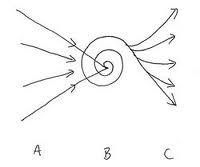The Comedy Bow-Tie of Innovation
Traditional innovation theory is full of funnels such as these. The thinking is that lots of ideas miraculously appear and then are filtered down and developed until they are successfully launched into a predetermined gap in the market.
However it is widely acknowledged that this ‘linear model’ of innovation is a long way from reality. See here for lots more on that. Andrew Gaule has suggested here that the model is more like a bow-tie and building on that I’d like to suggest it is more like a comedy bow tie. Confused? Let me explain.
A comedy bow tie spins around in the middle for hilarious (!) comic effect.
The Comedy Bow-Tie of innovation on the other hand is a little something like this (excuse the hand drawing but I couldn’t figure out an easy way of doing spirals)
- Phase A – Lots of potential inputs. New ideas are simply recombinations of old ideas
- Phase B – Iterate furiously
- Phase C – Breadth of market applications
All a bit like a comedy bow-tie don’t you think?
So to stimulate innovation one must:
- Legitimise scanning for new ideas from unlikely places e.g. Googletime (assuming you are already scanning in the usual places)
- Create the space to iterate – innovations never come fully formed and need to be developed and redeveloped many times. This requires time and small amounts of money e.g. Skunkworks
- Set up a mechanism to target multiple markets, this is seldom clear early on
What do you think? Does this make sense? And can you help us find a better name?

It looks like a whirlpool or tornado to me.
Perhaps you should make a little video of yourself describing it, with hand movements to see whether some of the message has been lost in transcription 🙂
Very creative Roland! I am not sure I agree though as I think constraints are very important to creativity and lead to DEPTH rather than BREADTH. In my experience it is DEPTH (of thinking) that is often missing from the innovation equation and this indeed does lead to a comedy bow tie and sometimes a clown attached to it….).
Good idea Lloyd 🙂
Brendan – thanks for the comment and I totally agree that constraints are really useful and necessesary in focussing an innovation process. Without them, you are almost certain to fail. However I’m sure you’ll agree that there are times when the potential applications of an idea are broad and far from obvious in advance, which a standard innovation funnel doesn’t allow for. Therefore it’s worth engineering in the space to scan and test for these possible new and non-obvious markets.
Roland
[…] post from a few years ago where we described open innovation as resembling a comedy bow tie (see here) but that’s another story. Post a comment or leave a trackback: Trackback URL. « […]
http://www.firstcolumbiabank.com
The Comedy Bow-Tie of Innovation | 100%Open
Hi there, thanks for your engagement. Can we help?